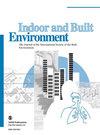中国东北地区住宅建筑室内挥发性有机化合物动态及季节性通风策略
IF 2.9
3区 工程技术
Q2 CONSTRUCTION & BUILDING TECHNOLOGY
引用次数: 0
摘要
本研究采用问卷调查的方式,收集了长春市 265 户居民的数据,内容包括建筑物特征、通风频率和对室内环境的总体满意度。统计分析显示,通风频率和对室内温度的满意度存在明显差异。调查结果显示,长春居民室内空气交换的主要方式是开窗通风,占 93%。在冬季和夏季,对居民楼室内空气中的挥发性有机化合物(VOCs)浓度进行了实地跟踪测量。研究显示,冬季目标 25 种挥发性有机化合物浓度的平均室内/室外(I/O)比值从 10.8 上升到 17.7。研究结果表明,室内来源是测量到的挥发性有机化合物的主要来源。温度、湿度和房间功能是影响挥发性有机化合物浓度的主要因素。温度升高和相对湿度增加都会导致室内挥发性有机化合物浓度升高。本研究建议在夏季高温高湿时多开窗通风,以保持良好的室内空气质量,并有效抑制家具挥发性有机化合物的排放。这项研究有助于加强寒冷地区室内空气质量数据库和有效的通风策略,以保障公众健康。本文章由计算机程序翻译,如有差异,请以英文原文为准。
Dynamics of indoor volatile organic compounds and seasonal ventilation strategies for residential buildings in Northeast China
This study utilized a questionnaire survey to collect data from 265 residents in Changchun, encompassing building characteristics, ventilation frequency and overall satisfaction with the indoor environment. Statistical analysis revealed significant disparities in ventilation frequency and satisfaction with indoor temperature. The survey results indicate that the primary mode of indoor air exchange amongst Changchun residents is window ventilation, accounting for 93%. Field tracking was conducted to measure indoor air concentrations of volatile organic compounds (VOCs) in residential buildings during winter and summer seasons. The study revealed a significant increase in the average indoor/outdoor (I/O) ratio of the targeted 25 VOC concentrations in winter, rising from 10.8 to 17.7. The findings underscore indoor sources as predominant contributors to the measured VOCs. Temperature, humidity and room functions are the main factors affecting VOC concentration. Higher temperatures and increased relative humidity both contributed to elevated indoor VOC levels. This study recommended the opening of more windows during high temperature and high humidity in summer, to maintain good indoor air quality and effectively age the emission of VOCs from furniture. This study contributes to the enhancement of the database on indoor air quality and effective ventilation strategies in cold regions for safeguarding public health.
求助全文
通过发布文献求助,成功后即可免费获取论文全文。
去求助
来源期刊

Indoor and Built Environment
环境科学-工程:环境
CiteScore
6.40
自引率
25.00%
发文量
130
审稿时长
2.6 months
期刊介绍:
Indoor and Built Environment publishes reports on any topic pertaining to the quality of the indoor and built environment, and how these might effect the health, performance, efficiency and comfort of persons living or working there. Topics range from urban infrastructure, design of buildings, and materials used to laboratory studies including building airflow simulations and health effects. This journal is a member of the Committee on Publication Ethics (COPE).
 求助内容:
求助内容: 应助结果提醒方式:
应助结果提醒方式:


